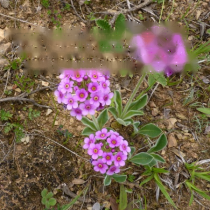
Chinese name: Diandimei
Latin name: Androsace umbellata
Aliases: Throat grass, Tongqian grass
Distribution area: All over the country
English name: Herba Androsacis
Mode of cell division: mitosis
1. Morphology of Prunus chinensis
Plum pipiensis It is an annual or biennial herb, the main root is not very obvious, and there are many fibrous roots. The leaves all grow from the roots, the shape of the leaves is oval or nearly circular, with a diameter of 5 to 20 mm, the length of the petiole is 1 to 4 cm, and the hairs are spread pubescent. Scapes often grow from among the foliage, are four to fifteen centimeters tall, and are covered with white pubescent hairs. Umbels with four to fifteen flowers. Bracts are ovate to lanceolate. The length is 3.5mm to 4mm. The pedicels are relatively slender, ranging from one to three centimeters in length, and the fruit can extend up to six centimeters.
2. Habits of Diandimei
Diandimei likes moist, warm, sunny environment and fertile soil, and often grows in mountain grassland or roadside. But whether it is in the alpine grassland or in the river valley beach, as long as there is a little bit of poor soil, it can take root and sprout. Its seeds can self-sow and reproduce. It can also survive in ice and snow. Diandi plum is produced in the provinces of Northeast China, North China and the south of Qinling Mountains. Grows in forest margins, grasslands and sparse forests. North Korea, Japan, the Philippines, Vietnam, Myanmar, India are distributed. Type specimens were collected from Vietnam.
3. Pharmacology of Prunus chinensis
The ethanol extract of the whole plant of Throat grass, the normal saline solution after removing impurities by lead acetate, is effective for cold-blooded and warm-blooded animals in vitro and in vivo The heart showed obvious cardiotonic effect; blood pressure gradually increased after intravenous injection to rabbits and cats, and blood pressure decreased before death; it showed excitatory effect on isolated rabbit intestines and rat uterus; rabbits and guinea pigs Defibrillated blood showed strong hemolysis; for example, after the saponins contained in it were removed with amyl alcohol and basic lead acetate, there was still a significant cardiotonic effect on isolated frog, rat heart and in vivo guinea pig heart. However, the dose used is increased compared with the aforementioned ones. The treated solution does not contain non-specific cardiac excitatory substances, such as calcium and tannin, but contains sugar or other reducing substances.
Guess you like it
Hibiscus | Hibiscus | Periwinkle | Thousand Days Red | Pomegranate Flower | | Top Ten Credits|
Calendula | Five-color Plum | Onion Orchid | Morning Glory | Lai | Roselle |
Daisy | Chrysanthemum | Pear | Wisteria | Calla Lily | Rose | Cymbidium | Rosemary | |
Almonds| Banchi| Oleander| Roses| Mimosa| Hibiscus| Geranium|
![[Dog Training 5] The training method of pet dog dining etiquette](/static/img/12192/12192_1.jpg)




